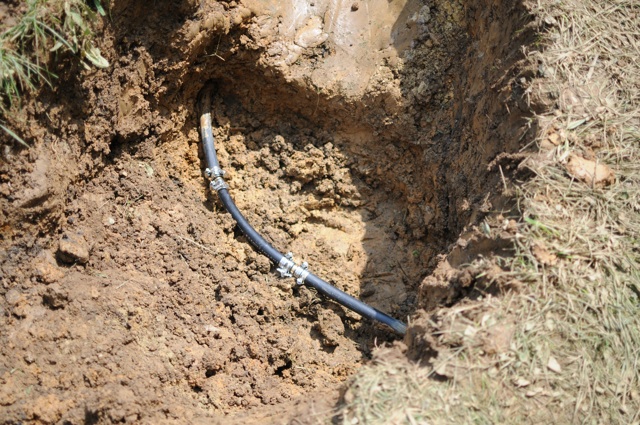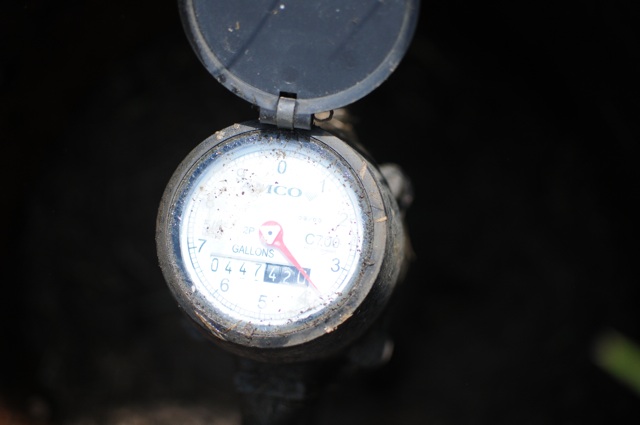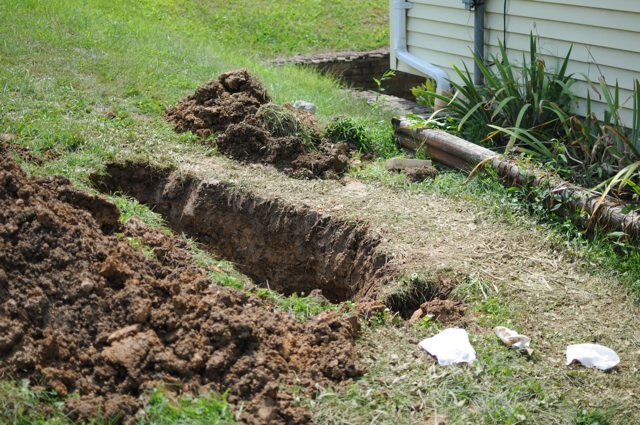I usually love coming home from a business trip. Nothing like my own bed, my own shower, etc… But monday night was something I did not want to come home to. When I pulled in the driveway I could not understand why there was water on the driveway when it hasn’t rained in quite a while. I then looked at the retaining wall next to the driveway and there was a nice little bit of water “falling” over it. Still could not understand where it was coming from as where that water was the only thing there was the gutter drain, and it hasn’t rained.. So I then look up in my yard and what do I see a little 3 to 4 inch water fountain coming out of the ground. The ground had risen about 3 to 4 inches around where the water was and made a nice little hump. Oh SHIT…. I immediately ran up and shut off the main water valve at the water meter. The water fountain goes away and the hump goes down… Oh shit my water line has broke….
So I called MUB and they were like “Sorry if it is between the meter and your house it is your own problem.” Freaking awesome, they place the meter 2 foot from the road and there is like 35 feet between it and the entrance to my house. So I grab the shovel and start digging and digging and digging. One thing about a water leak, it sort of tells you where it is at by where the fountain was. So after a while a friend from work and his dad and my parents show up.. My friend and I continue digging. All the time thinking that the line we are looking for is a metal line, because it is metal at the meter and metal in the house.. But NO for some stupid ass reason they put converters on it and converted it to 3/4 inch PLASTIC. So we keep digging and then turn the water on a little to have it “clear” the way so we can see where the line is. Finally after about an hour we find the pipe. It has about a 1 inch slice in it.
Now it is 5 minutes till 9PM, haven’t eaten yet, been on the road for 5 hours and now I am realizing I am not getting any water this evening. My mom tries to make a dash for Lowes to get parts, but they are closed by the time she gets there. So I grab the 15 gallons of water my parents brought down and try to clean up some.
Fast forward to Tuesday morning I make a dash to Lowes as soon as they open. “We are sorry, we don’t sell the stuff to fix your pipe”. WTF, you are a home improvement store but you don’t sell stuff to fix pipe even though you sell the pipe? So off to Hugarts, this is one of those places where if they don’t have it, more than likly you don’t need it in the first place. With parts in hand I head home to fix the pipe. If you have never worked on 3/4 inch water supply line that is plastic, (this being my first time), it was a chore. Luckly the piece I cut fit the bend perfectly that was already there. But the hard part was putting the joiners in and getting everything tight. So here is what it looked like when I was done:

Not sure if you can tell from the pic, but this was just over 2 foot under ground. So with the pipe fixed it is time to fire it up, turned the water on and everything seems fine.
Now was the time to try and figure out how much water had actually came out during the little problem. I looked at the meter and all I saw was this:

So doesn’t tell me too much as I don’t know how they read the meters. (I say this because on my last water bill all it said was 287 was the meter reading). So I called MUB and they said they would come out some time before 3 tomorrow (Wednesday) and do a meter reading. I could not fill the dirt back in because they had to “verify” that my line did break.
So MUB shows up today and I go out to talk with the guy. I asked him what they were actually reading when they read the meter. Short answer the first 3 digits. So I thought to my self oh shit… See the current reading was 447,420. When my meter was last read (6.1.09) the first 3 digits was 287. So that tells me that between 6.1.09 and today there has been 160,000 gallons of water go through my meter. As a prospective, my bill (based on 3 months) is usually only 6,000 gallons. So 160,000 gallons is enough for me for 6 years. This is when I told the guy, “damn that is a lot of water, wish I had a pool to put it in.” He sort of laughed and said that is more water than goes in to a pool. (So I looked it up, 160,000 gallons of water is equivalent to 27 foot cube. That is a metric fuck-ton of water, to quote a DefCon goon….)
So the MUB guy leaves and now I start filling in the hole, thinking to my self how am I going to pay for the equivalent of 6 years of water and sewage. Here is the coffin I mean ditch that I had to start filling in:

It got to the point it was too hot and I pissed off some yellow jackets so I went in side and waited a couple of hours. Went back and finished filling it in and it now looks almost like it did before I started:

So now I have to call MUB tomorrow to see what they are going to do. Hopefully I can get a waiver, as there was no way to tell the line was broke until the fountain sprouted. I guess I could go out side and read the meter every day, but who does that?
So leads me to the title. I wish I would have at least had a pool to put all that water end, at least I could have enjoyed it, rather then digging through the mud and clay for 4 hours.
